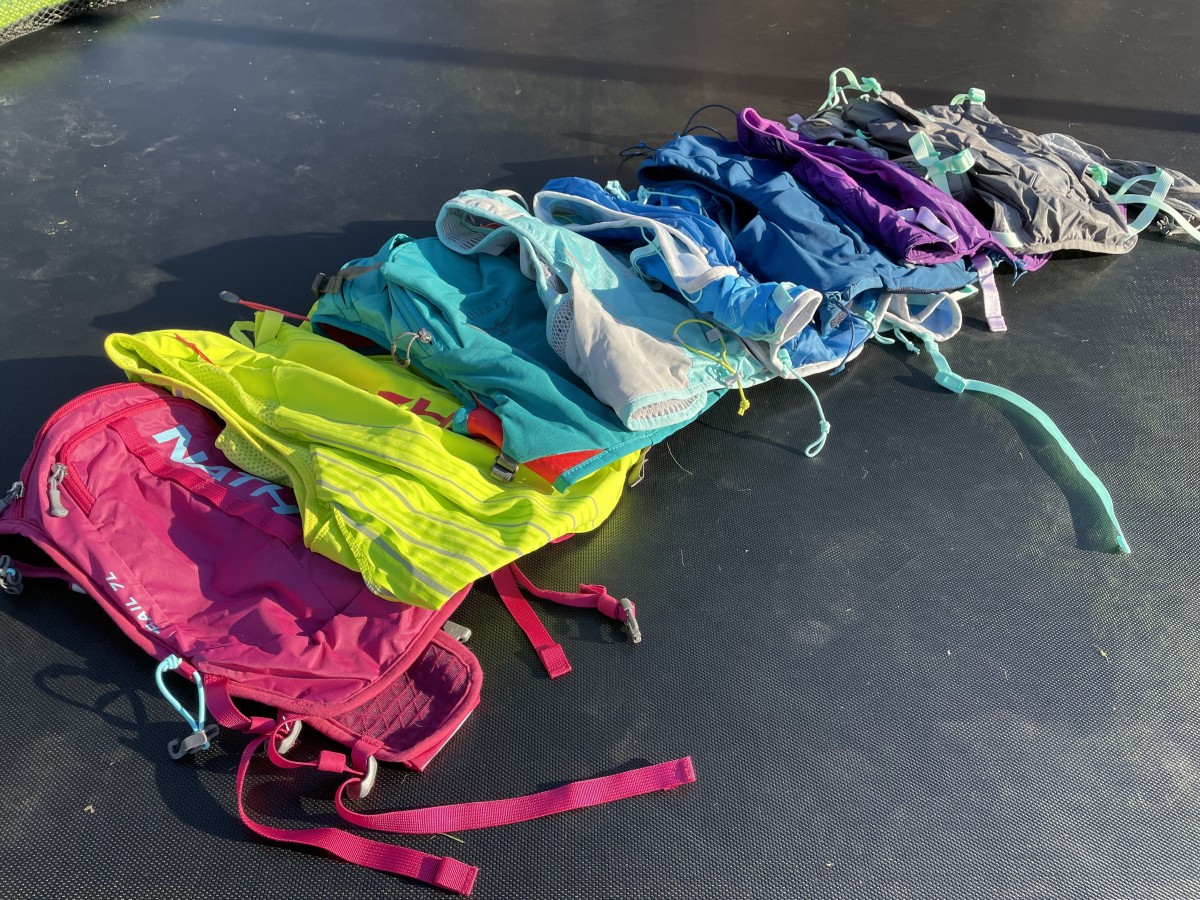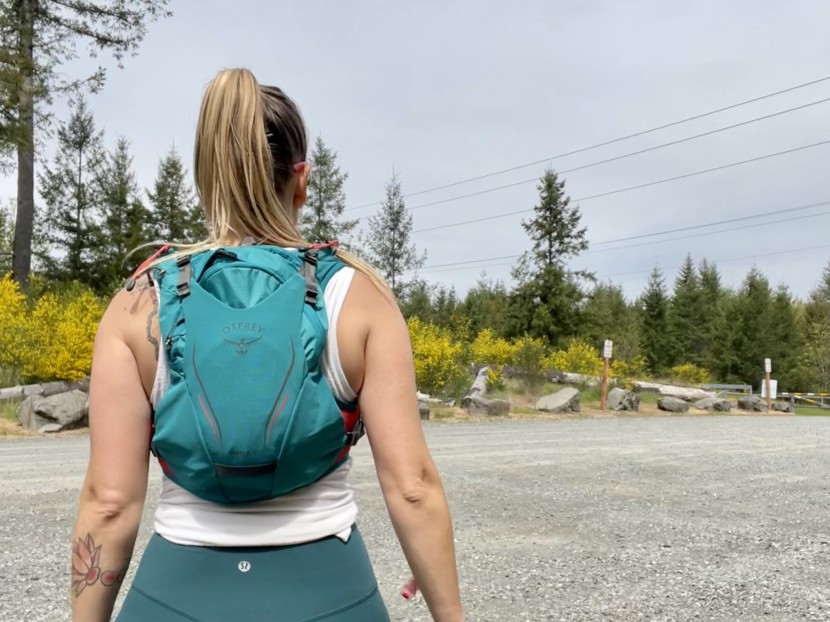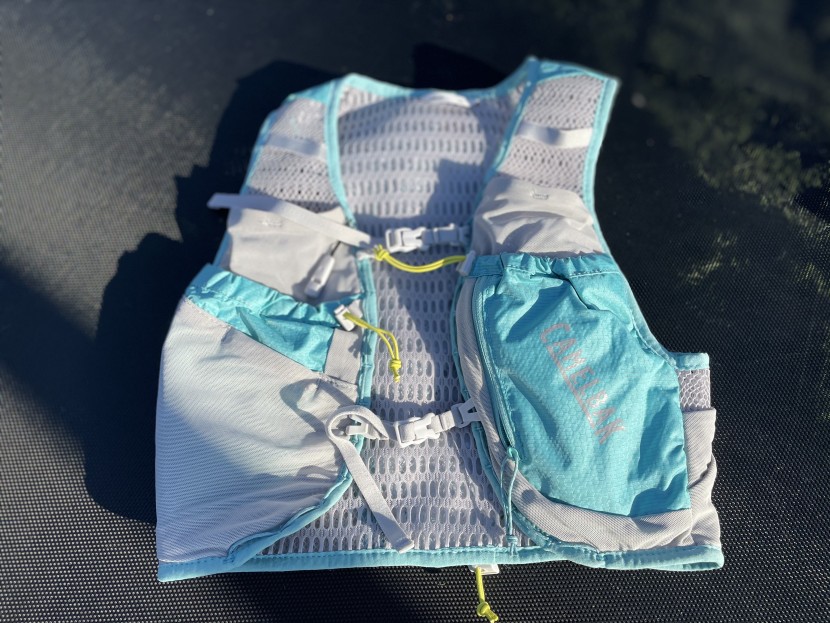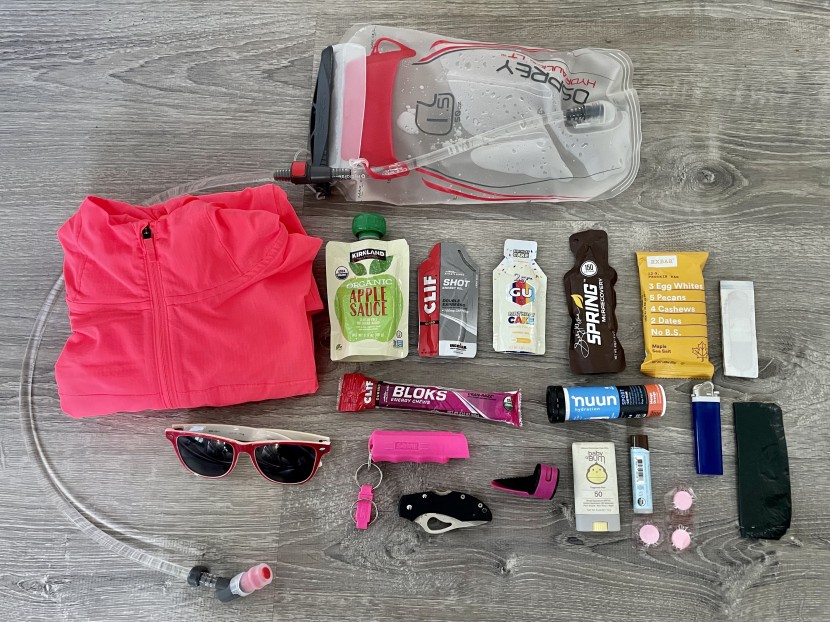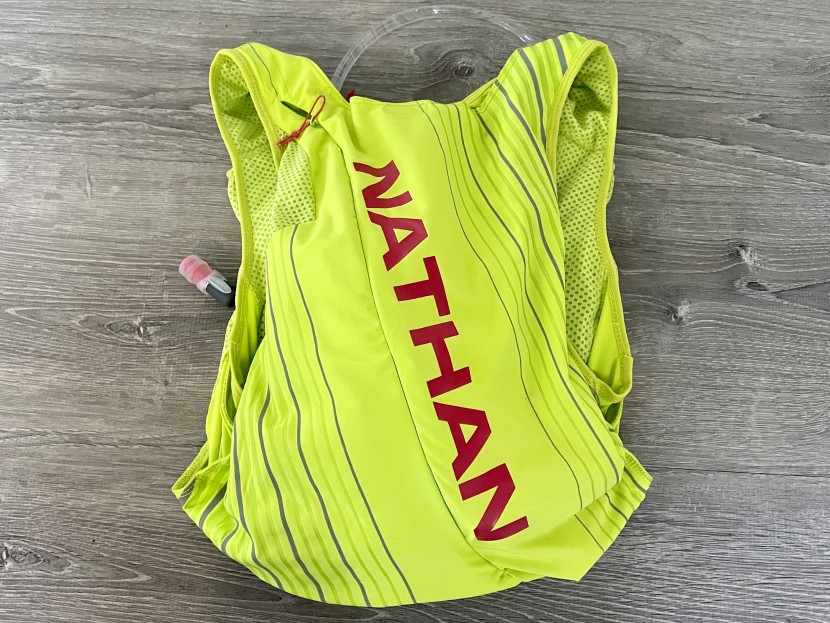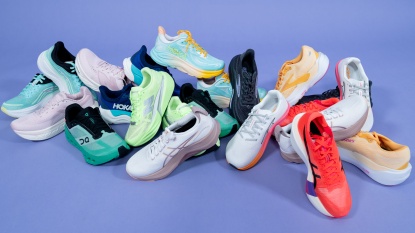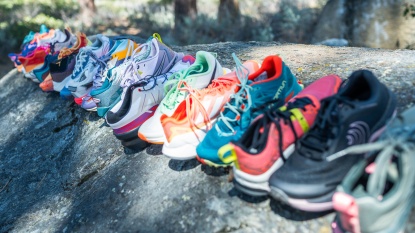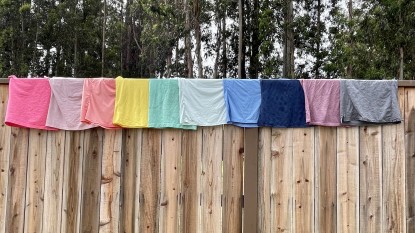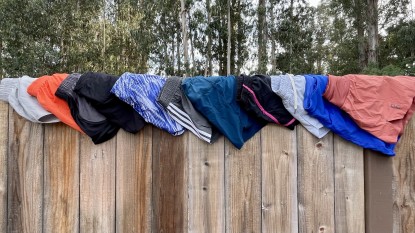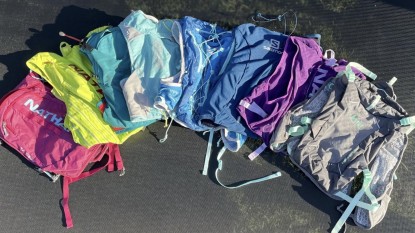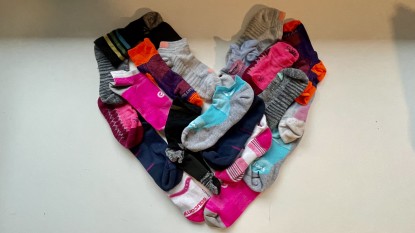Are you in the market for a female-specific running hydration pack? You've come to the right place. Our running-obsessed gear testers have been hard at work testing some of the most popular hydration packs available on the market today. They've done the dirty work for you, so all you'll have to do is read on to determine which hydration system will work best for toting your water, snacks, and gear.
What is a Running Hydration Pack?
Ten years ago, you could have walked into an outdoor gear shop and seen but one hydration pack stuffed into a corner. Back then, you could have assumed that such a contraption was for the crazy older guy at your gym who enters 100-milers for fun. Nowadays, though, runners everywhere are zipping, clipping, and tightening their vests for everyday runs. There are even plentiful brands releasing female-specific vests for every runners' needs.
Running packs, AKA hydration vests, are svelte, apparel-like pieces of gear that allow you to grab your snacks, sip water, and access items without having to remove the pack. A running hydration pack is a mini backpack that rides close to your body and is built with extra suspension to reduce bouncing. The main draw of wearing a hydration pack is that you can haul all of your gear, namely water, without slowing down. These packs are specifically designed to accommodate a high volume of gear with a biomechanically sound presence. Once you invest in a running hydration pack, gone will be the days of you wandering through your local park in search of a drinking fountain. With a running-specific hydration pack, you can carry everything you need for a day in the backcountry on your body.
Manufacturers build these packs with elite, biomechanical engineers on their teams to ensure bounce-free, chafe-free, and otherwise comfortable rides. Every detail is painstakingly measured to ensure ease of access. You want your hydration pack to sit atop your clothing like it is another layer. Many of the available options offer well-rounded pockets and well-dispersed weight to ensure the proper fit. Furthermore, all running hydration packs come with cinch straps, bungees, and even size options to ensure secure, bounce-free runs.
Is a Running Hydration Pack Right for You?
If you've ever found yourself tucking your extra gel into your sports bra or safety pinning your ShotBloks to the waistband of your running shorts, you should consider a running hydration pack. Not only do these vests offer ample storage for your nutrition needs, but they also fit close to the body, so they minimize drag and won't affect your gait. Throughout our testing and lived experience, we have found that two main types of hydration packs dominate the market: backpacks and vests. However, this is not a rule, and some grey areas do exist. Many of the backpack-style hydration packs cross over into the vest-style territory and vice versa.
For our purposes, we have delineated this by determining where the majority of the weight rides when the pack is stuffed full of running gear and water. All of the packs that we tested have large back pockets that accommodate hydration bladders. On some, the bulk of the pockets are located on the pack's backside, save for a few small pockets in the front. Conversely, some hydration packs have pockets on every surface, thus evenly distributing the weight of your gear; these are the ones we deem “vest-style.” We don't know which style is right for you, as one is not superior to the other. Both styles offer technically sound hydration systems and ample space for the essentials. Your choice totally depends upon the type of running you do, how quickly you want access to your items, how much gear you want to tote, and ultimately, what feels right for your body.
Vest-Style
As mentioned above, vest-style hydration packs offer well-distributed pockets to disperse the bulk of the weight. In general, this style of pack can accommodate a few liters more gear than backpack-style packs. Many of the most popular vest-style packs have built-in compression systems to ensure that your gear rides close to your body. Since this style of vest can accommodate more gear, they often have bigger and deeper pockets. Furthermore, vest-style hydration packs use the underarm areas to sneak in even more storage. If you want to haul a lot of gear and be comfortable while you do so, we recommend trying out a vest-style hydration pack first.
Backpack-Style
Backpack style hydration packs tend to place the bulk of the weight towards the back of the pack. This pack style usually doesn't utilize the underarm areas for storage, as it is often comprised of just a cinch strap or two. Additionally, backpack-style hydration vests tend to have smaller capacities and less creative storage options. This isn't necessarily a bad thing; it all depends upon your needs. If you are a hiker who is trail running-curious, a backpack-style hydration pack might be right for you. We love this pack style for days when we want to bring the basics: water, an extra layer, a few gels, and our bare-bones first aid kit. These items, and more, have plenty of space, even in the more minimal versions. Backpack style packs are also often more durably built than the silky-smooth vest versions. Because of their more rugged textiles, they tend to be a bit weightier. This style typically doesn't have built-in compression features. Still, they can be more customizable due to their extra straps and loops.
Optimizing Fit
Our main reviewer remembers buying a tiny CamelBak intended for little girls when she first got into endurance running. It didn't have any horizontal cinch straps, it chafed her underarms like crazy, and it bounced while she ran. Talk about an improper fit! The endurance revolution is upon us, and with it comes so many size and fit options. It seems crazy to consider running an ultra marathon in an ill-fitted pack. We've done it, and we don't recommend it. Read on to discover how to find your best-fitting running sidekick.
Sizing
The best place to begin when choosing a running hydration pack is to pick the appropriate size. Many brands are now offering multiple size options that follow standard American sizing guidelines. This makes your starting point super simple to find. We think that the two main measurements to take are your bust and waist. If you are unsure about finding your size, just grab a piece of string so we can talk you through it. Once you have your string, wrap it around the widest part of your bust, and mark where it connects. Do the same thing around the smallest part of your waist. After you've made your two marks, measure the length to each tic mark with your tape measure in inches. With these two values in mind, you can reference the size chart available on most manufacturers' websites to find your starting point. Bear in mind that your measurements may not correspond exactly to the numbers listed on the size charts. But after compulsively buying and testing gear for years, we've found it to be a legit system of measure.
Adjustment Options
In addition to the myriad sizing available, each pack comes equipped with options for customization, some more than others. The simplest of these adjustment options is the classic cinch-strap option. Though variations exist, nearly every running hydration pack employs a horizontal clip and cinch strap option to secure everything 360 degrees around your body. Whether you have to feed the strap through the clip or tighten a bungee, this remains the most basic way to begin fitting your hydration pack. Most of the popular options allow the horizontal straps to be moved vertically. We are sure that men like this too, but it is super important to female runners. Every woman's body is shaped differently. We fluctuate so much up top that we have to be able to move the pressure of the straps so it doesn't sit directly atop our breasts. This is particularly valuable for those of us who swap out our sports bras with regularity. Sometimes the straps work in tandem with those of your bra, other times, they won't. We need to customize the fit of our pack based upon the other pivotal parts of our arsenal.
Many vests have underarm adjustment options as well. Again, these can be cinch straps or bungees but ensuring a tight fit around the contours of your waist will help the pack stay in place over technical terrain. We love the covert underarm adjustment options that allow the excess straps to be tucked away. Flapping straps might not bug you much at mile 3, but by mile 30, they could end up being your undoing.
Ease of Adjustment
It is important to us to have easy adjustments since we often adjust in the middle of a run. Once you start to drain your hydration bladder, deplete your snack reserves, and don your weather-proof layer, the shape of your frameless pack can change. We think it is really valuable to have a pack that offers easy-to-use cinch straps and cords so it can sit snugly on your body.
Breathability
Breathability and comfort go hand-in-hand. While we have never been known to DNF (did not finish) due to extreme sweat, breathability is key when evaluating comfort. Generally speaking, the vest-style running hydration packs cover more of your skin. With this in mind, it is extremely important to invest in a pack made of breathable, moisture-wicking fabric. The backpack-style packs can get away with being less breathable because they cover your skin less by nature. Many backpack-style packs have mesh backings and straps to aid in this exact thing. Our advice when surveying breathability is simple; if it touches a lot of skin, make sure the fabric is light, preferably with laser-poked holes.
Features
As the 21st century rambles on, we continue to race to keep up with technology. While we are sure this is true in other areas, we are gear testers, so we mostly know how this advent in tech relates to our gear. Now more than ever, we see ultra-light materials made accessible to all. As weight-conscious runners, this is highly exciting. But the leaps in technology don't stop at just fabrics. We are seeing new features popping up left and right. Below, we outline some of our favorites and explain why you might want to consider them or not in your hydration pack investment.
Safety Features
As women, we are taught not to run alone at night, not to run in “sketchy” areas, and not to wear shorts that are too short. While none of the safety features included on these hydration packs can truly make up for the horrendous actions someone else chooses to take, we are happy to report that some of them can aid in our safety. Most notably, many hydration packs are now coming with lightweight safety whistles built into them. This feature isn't just helpful for ensuring women's safety; it is great for anyone who might find themselves needing help out in the backcountry. While easily-accessed pockets aren't technically a safety feature, we prefer running with our weaponry stashed in quick-draw pockets just in case.
We took a dark turn there, we know. But as female runners, we've given this a lot of thought and want all runners to stay safe on the trails. Ultramarathons are becoming more popular than ever, and with that comes nighttime racing and more training. Many of the hydration packs we tested have reflective stripes along their backs. Again we say, this is not enough to ensure safety, but we love knowing that it can aid in visibility. Many packs offer daisy chains and bungees on their back panels; these are great places for attaching lights or other reflectors.
Trekking Pole Storage
A sometimes-vital but less macabre feature offered on many popular running hydration packs is the option to haul your favorite trekking poles. As high-mountain races become more popular, many runners like carrying trekking poles to assist them on especially tough terrain.
If you've been paying attention, you probably noticed that we run with a lot of gear, from self-defense weaponry to snacks, to extra clothing, first aid kits, and of course, dog treats for our BFFs. We are not in the habit of running with trekking poles, but we absolutely see the value in it. Because of this, we test our packs with a clunky, outdated set of poles that we whip out when bagging the steepest peaks. Only you know what is right for your body. If your body begs for you to run with poles, please use them!
We have discovered a few popular ways to stash your poles on the go. Often, bilateral bungees are attached to the shoulder panels to secure the upper parts of the poles vertically. Then there can be matching loops on the lower portion of the pack or deep, easy-access pockets. This style of pole storage is great for maintaining even weight distribution. Since the lower parts of the poles get stashed low, they tend to sit closer to your body which helps decrease drag and the sensation that you're hauling a lot of weight. Another popular way to stash trekking poles is together through center bungees. This is super effective but doesn't offer the best ease of access, as we notice the non-flush elements of the poles can get caught on the bungees. Sometimes when our poles are tethered this way, we notice the feeling of weight being farther off our backs. This is generally not problematic when hiking, but it can become burdensome amid a run. Finally, we have seen some horizontal pole attachment options. The poles can be secured in bungees, Velcro, or a kangaroo (pass-through) pocket at the base of the pack. If you like running with super-compact, collapsible poles, this is the style we recommend. The weight of the poles generally sits low and tight. Just be mindful of how much your poles can collapse, or you might end up with a super-wide load!
Hydration System
The hydration system in your pack is incredibly valuable. After all, this is what is going to keep you going mile after mile. Most running hydration packs come with only one hydration system included but usually have the capacity to employ one of two systems. Though some hydration bladders only accommodate 1L of water, they generally offer a bit more space and can haul more water comfortably when compared to bottles, which are usually 500mL each. There is no right way to hydrate on a run, so long as you're doing it. You may find that you like the accessibility of bottles the most. Or you might decide that the fit and feel of a hydration bladder suits you better. You could also decide that you like running with both. It's all about personal preference and what you find comfortable.
Hydration Bladder
Hydration packs for running often can hold 1.5L-2.0L of water in a bladder. To use this system, you fill a thick, plastic-like bag with water, seal it up, and then tuck it into the innermost pocket of your pack. When done right, the bladder should flatten out and ride comfortably against your back.
There is usually some type of suspension agent that holds the top of the bladder in place. A hose runs from your upper back, over one shoulder, and then down a breast panel through a series of loops. Most of the current market offerings come with some kind of clip on the boning to secure the hose. You can opt to secure the hose with the mouthpiece facing down and reach down to grab it for a sip. Or, you can loop it so that the mouthpiece faces up and is close by your mouth. No matter which configuration you choose, using a hydration bladder is a great way to ensure that you can tote a lot of water on your adventure days. A notable downside of using a hydration bladder is that you can only carry one liquid at a time. And, if you happen to guzzle all of your precious H2O, it can be a pain to unload your bladder and fill it mid-run. That said, some packs are now coming with insulated pockets for the bladder — what a treat.
Soft Bottles
Another popular way to travel into the backcountry with accessible, easy-to-carry water is with breast bottles. Most of the bottles that are available today are made of soft, BPA, and PVC-free plastic. There are still a few options for hard chest bottles but since those are becoming increasingly less popular, let's discuss the soft ones.
Soft bottles, or soft flasks, are made to fit into the closest fitting chest pockets sewn into your vest. Similar to a hydration bladder, these are designed to be worn close to your body. The mouthpieces vary. Some vests come equipped with straw-like contraptions to sip from; others have athletic bottle spouts. The pockets will have some type of bungee or elastic to secure the top of the bottle. We love soft bottles on shorter excursions but often find that they don't offer enough volume for us to stay hydrated on ultramarathon-style runs. They usually each hold 500mL of water, making their total capacity 1L.
Throughout our time as running fiends, we have garnered a few lessons about breast bottles. The first lesson we've learned is that taking your soft flask out of its pocket to sip usually ends in an inconvenient, mid-trail stop to try to shove it back into its home. Many makers who use this style of bottle engineer vests that sit higher on the body so the mouthpieces can be closer to your mouth. As is often the case, it comes down to personal preference. If you like the weight of your pack to ride high, you might find this hydration system to be the one for you. With low riding packs, the mouthpieces are carried lower too, and this may cause problems if they don't have straws. A benefit of running with bottles is that you can bring more than one type of liquid. We like to fill one with water and one with an electrolyte beverage for sweaty, hot day adventures.
Volume to Weight Ratio
Volume to weight ratio is a simple equation that we use to determine how much a pack can hold relative to its weight when empty. This might not sound very easy at first, but stay with us. To decide how this ratio relates to you, we'll need first to determine how much gear you should reasonably be running with. If you like shorter excursions, you could consider a lower capacity option. If all-day runs are more your style, we recommend looking at the vests with larger capacities. Keep in mind that comfort should be a main priority when buying your first running vest. Once you've narrowed down your average run length, you can lay out all of the gear you like to bring. We usually bring an extra layer, a pair of socks, plenty of snacks, hydration, sunblock, a small first aid kit, a handkerchief, pepper spray, and a knife. Some people run more prepared. Some people run with less. This is, as you probably guessed, about your preferences. All of those things we listed are enough to stuff a 5L pack full but leave a 12L pack with plenty of space for more. After you've listed out all of the gear you like to take with you, you can consider how much space you reasonably need to tote it all.
To calculate the ratio, we divide the total carrying capacity (as listed by the manufacturer) by its empty weight in ounces (measured by us). But why are we calculating this? Some runners and backcountry lovers are weight-obsessed. We love to haul as much gear as we can in the lightest way possible. Especially when it comes down to shaving seconds off your time, or edging out the competition, weight matters! If you are a casual trail runner who enjoys the sport as a whole, the pack's weight won't slow you down too much. If you have more of a minimalist vibe on the trail, it will serve you to find the smallest pack that works for you, so you aren't tempted to load up with more gear.
Pockets
We love pockets, and we find that womens' running gear never has quite enough of them. The purpose of pockets is obvious — to stash all your thangs! Running-specific hydration vests are designed so that the front pockets can be accessed while you are moving. When you are in marathon mode, nothing stomps your flow like having to stop and shuffle things around in your pack to find your highly caffeinated energy gel.
Front Pockets
The front pockets on hydration vests can house a variety of quick-draw items. We tend to plan when we pack. We know we will want a gel 45 minutes into a run, so we keep one handy. We know we'll want our chapstick at some point, so it stays close, and we know we'll want our smartphones to see our downloaded map when we get into unknown territory. Front pockets can have mild elastic closures, bungee closures, zippers, Velcro, etc. Sometimes front pockets even have a variety. Throughout our years testing hydration packs, we have discovered one dynamic thing when evaluating pockets. As long as there is at least ONE secure pocket for stashing our car keys, we can make the rest work. That said, it's kind of a bummer when your smartphone doesn't fit snugly into a front pocket, so if that is a priority to you, be sure to test that out before you buy.
Back Pockets
The back pockets on running hydration packs are great for lesser-used items. When running deep into unknown areas, we stash a map and other smart safety items in these pockets. Our first aid kit typically lives in the depths of one of these pockets as well. These pockets are great for holding snacks that you might need down the trail and, of course, extra gear. Some packs offer various sized pockets on the backs of their vests, which definitely helps keep things organized. The way you choose to organize your gear on a run is very personal. We encourage you to sort out the details of what works for you and purchase your pack based on those preferences.
Conclusion
Choosing a running hydration pack can be a daunting task. Not only is technology advancing every season, but each maker also touts different features as the most necessary. We sorted through some of the most popular vests available to provide you with the most relevant information possible. We ran miles in each vest, packed each pocket with gear, and put each pack through the wringer so that we could dissect the most minute-seeming details. We learned a lot and hope that our meticulous testing and notetaking can help you find your new best running mate.

